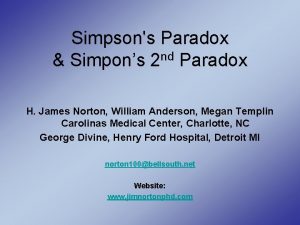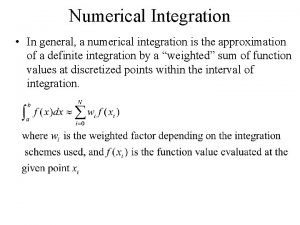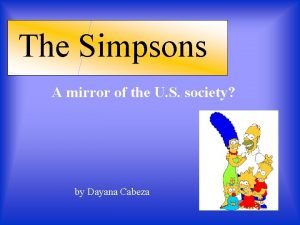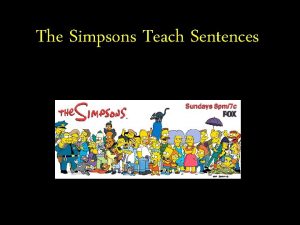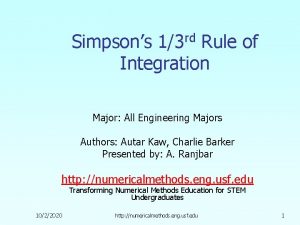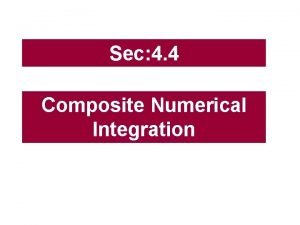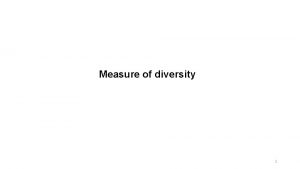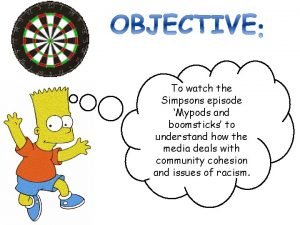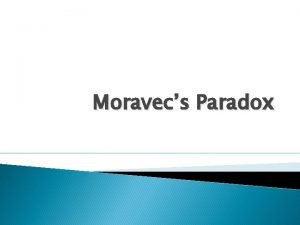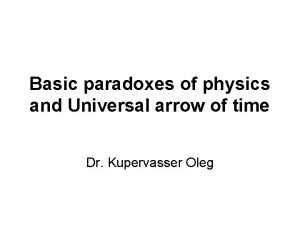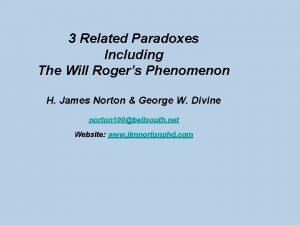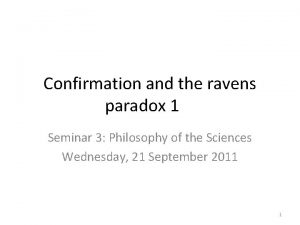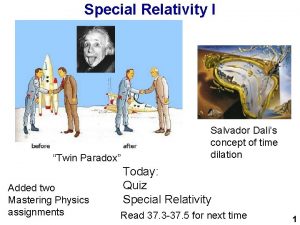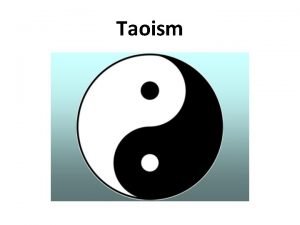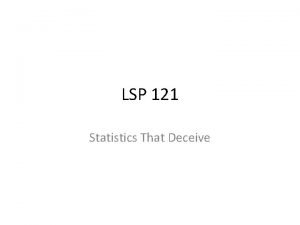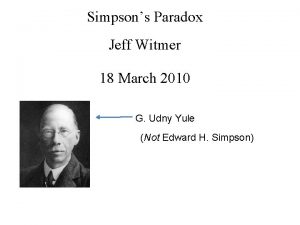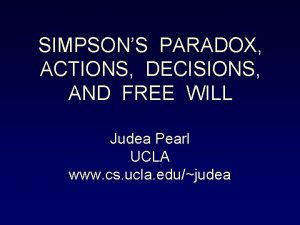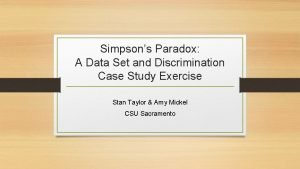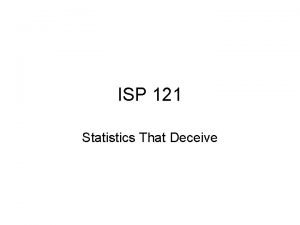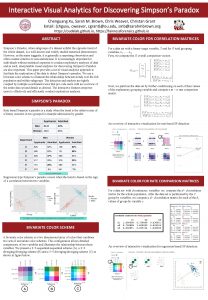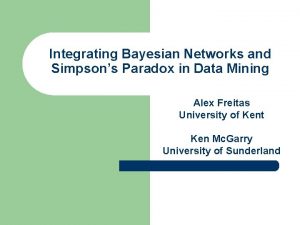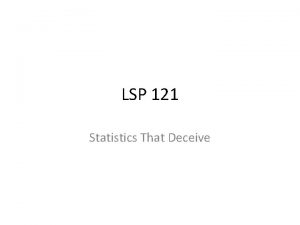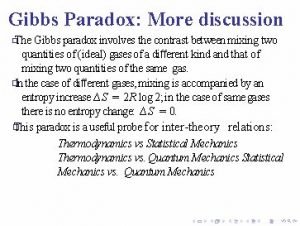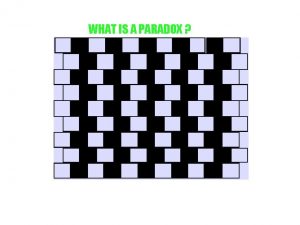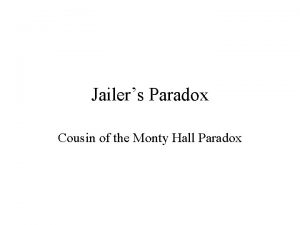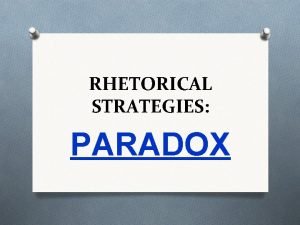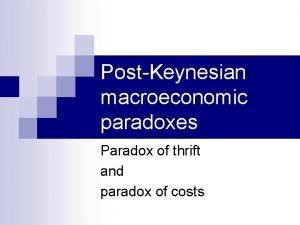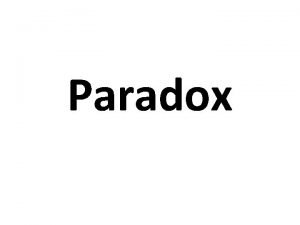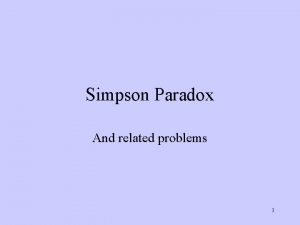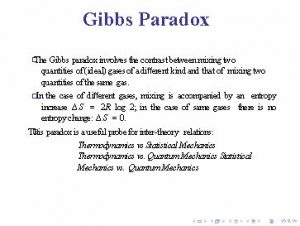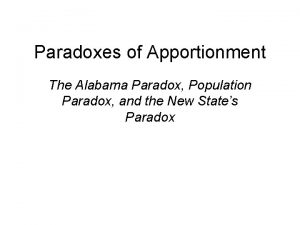Simpsons Paradox Simpons 2 nd Paradox H James









































- Slides: 41

Simpson's Paradox & Simpon’s 2 nd Paradox H. James Norton, William Anderson, Megan Templin Carolinas Medical Center, Charlotte, NC George Divine, Henry Ford Hospital, Detroit MI norton 100@bellsouth. net Website: www. jimnortonphd. com

• Paradox in published research goes back to at least the late 1800 s • See “The Pirates of Penzance” by Gilbert & Sullivan(1879)


Keeping undergraduate biology students and medical residents interested in statistics, when the majority of the students are taking the class as a requirement, can be challenging

The following are examples of Simpson’s Paradox that you might find helpful in your course instruction.

Survival Rates Died Survived Death Rate Hospital A 16 784 2. 0% Hospital B 63 2037 3. 0% In which hospital would you want to have your surgery, A or B? Moore, D. S. , Mc. Cabe, G. P. , 1999, Introduction to the Practice of Statistics, 3 rd edition: W. H. Freeman.

Patients in Good Condition Died Survived Death Rate Hospital C 8 592 1. 3% Hospital D 6 594 1. 0% If you are in good condition, in which hospital would you want to have your surgery, C or D? Moore, D. S. , Mc. Cabe, G. P. , 1999, Introduction to the Practice of Statistics, 3 rd edition: W. H. Freeman.

Patients in Poor Condition Died Survived Death Rate Hospital C 8 192 4. 0% Hospital D 57 1443 3. 8% If you are in poor condition, in which hospital would you want to have your surgery, C or D? Moore, D. S. , Mc. Cabe, G. P. , 1999, Introduction to the Practice of Statistics, 3 rd edition: W. H. Freeman.

Survival Rates Died Survived Death Rate (%) Hospital A 16 784 2. 0 Hospital B 63 2037 3. 0 Hospital C 8 592 1. 3 Hospital D 6 594 1. 0 Hospital C 8 192 4. 0 Hospital D 57 1443 3. 8 Good Condition Bad Condition Hospital A is the combined data for Hospital C, Hospital B is the combined data for Hospital D.

Simpson’s Paradox Refers to the reversal of the direction of a comparison or an association when data from several groups are combined to form a single group.

Brief History of Simpson’s Paradox • Yule, GU, 1903, “Notes on theory of association of attributes in Statistics”, Biometrika, 2: 121– 134. • Cohen, MR, and Nagel, E, 1934, An Introduction to Logic and Scientific Method, New York: Harcourt, Brace and Co. • Simpson, EH, 1951, “The interpretation of interaction in contingency tables”, Journal of the Royal Statistical Society (Series B), 13: 238– 241. • Blyth, CR, 1972, “On Simpson's Paradox and the Sure Thing Principle”, Journal of the American Statistical Association, 67: 364– 366. • Bickel, PJ, Hjammel, EA, and O'Connell, JW, 1975, “Sex Bias in Graduate Admissions: Data From Berkeley”, Science, 187: 398– 404.

Conditions when Simpson’s Paradox will not occur: Sample sizes are the same Died Survived Death Rate (%) Hospital A 20 380 5. 0 Hospital B 132 2868 4. 4 Hospital A 12 188 6. 0 Hospital B 75 1425 5. 0 Hospital A 8 192 4. 0 Hospital B 57 1443 3. 8 Good Condition Bad Condition # Hospital A Good Condition = # Hospital A Bad Condition = 200, # Hospital B Good Condition = # Hospital B Bad Condition = 1500

Conditions when Simpson’s Paradox will not occur: Rates are the same Died Survived Death Rate (%) Hospital C 32 784 4. 0 Hospital D 95 2405 3. 8 Hospital C 24 576 4. 0 Hospital D 38 962 3. 8 Hospital C 8 192 4. 0 Hospital D 57 1443 3. 8 Good Condition Bad Condition

Examples of Simpson’s Paradox in the Literature Study Type Author Dependent Variable Independent Variable Stratification Variable Epidemiological Cohen death location race Epidemiological Morrell medical aid children (followed, not followed) race Epidemiological Severijnen urinary tract infection antibiotic prophylaxis (y/n) incidence of urinary tract infection Legal Bickel admission gender department Legal Blume death sentence race of offender race of victim Medical Charig success removing kidney stones open surgery or percutaneous kidney stone diameter (<2 cm) Medical Gatling death insulin dependent (y/n) age (<40) Psychological Hand percent male year (1970/1975) age (<65)

Severijnen AJ, Verbrugh HA, Mintjes-de Groot AJ, Vandenbroucke. Grauls CMJE, van Pelt W. Sentinel System for nosocomial Infections in the Netherlands: A Pilot Study. Infect Control Hosp Epidemiol 1997; 18: 818– 824. Low incidence hospitals UTI No UTI % with UTI Antibiotic Prophylaxis 20 1093 1. 8 No Antibiotic Prophylaxis 5 715 0. 7 Antibiotic Prophylaxis 22 144 13. 3 No Antibiotic Prophylaxis 99 1421 6. 5 Antibiotic Prophylaxis 42 1237 3. 3 No Antibiotic Prophylaxis 104 2136 4. 6 High incidence hospitals Combined

C. Morrell, Mathematical Science Department, Loyola College, Baltimore, MD Caucasians Medical Aid No Medical Aid Rate of Medical Aid (%) Children not traced 104 22 82. 5 Five-year group 10 2 83. 3 Children not traced 91 957 8. 7 Five-year group 36 368 8. 9 Children not traced 195 979 16. 6 Five-year group 46 370 11. 1 African Americans Combined

Hand DJ. Psychiatric examples of Simpson's paradox. Br J Psychiat 1979; 135: 90– 1. Age < 65 Male Female Percent Male Year 1970 255 174 59. 4 Year 1975 156 102 60. 5 Year 1970 88 222 28. 4 Year 1975 82 175 31. 9 Year 1970 343 396 46. 4 Year 1975 238 277 46. 2 Age >/= 65 Combined

Cohen, M. R. , and Nagel, E. , 1934, An Introduction to Logic and Scientific Method, New York: Harcourt, Brace and Co. Death Rates from Tuberculosis in Richmond and New York City in 1910 Caucasians Died Survived Death Rate per 100, 000 (%) New York 8, 365 4, 666, 809 178. 9 Richmond 131 80, 764 161. 9 New York 513 91, 196 559. 4 Richmond 155 46, 578 331. 7 New York 8, 878 4, 758, 005 186. 2 Richmond 286 127, 342 224. 1 African Americans Combined

Charig, C. R. , Webb, D. R. , Payne, S. R. , Wickham, J. E. "Comparison of treatment of renal calculi by open surgery, percutaneous nephrolithotomy, and extracorporeal shockwave lithotripsy. Br Med J (Clin Res Ed) 292 (6524): 879– 882. Kidney stones < 2 cm success failure % successful Open 81 6 93 Percutaneous 234 36 87 Open 192 71 73 Percutaneous 55 25 69 Open 273 77 78 Percutaneous 289 61 83 Kidney stones >= 2 cm Combined

Gatling W, Mullee MA, Hill RD. The general characteristics of a community based population. Practical Diabetes 1989; 5: 104 -7. Patients age <= 40 Insulin Dependent Died 1 Alive % Died 129 0. 8 15 0. 0 104 124 45. 6 Non-Insulin Dependent 218 311 41. 2 105 253 29. 3 Non-Insulin Dependent 218 326 40. 1 Non-Insulin Dependent 0 Patients age > 40 Insulin Dependent Combined Insulin Dependent

Blume JH, Eisenberg T, Wells MT; Explaining Death Row’s Population & Racial Composition; Scholarship@Cornell: A Digital Repository; 3/1/2004. Indiana Death Sentence Rate Murders # of death sentences Death sentence rate Black offender 2, 151 12 5. 6 White offender 100 0 0 Black offender 375 16 42. 7 White offender 2, 272 49 21. 6 Black offender 2, 526 28 11. 1 White offender 2, 372 49 20. 7 Black victim White victim Combined

Bickel, PJ, Hammel, EA and O’Connell, JW. Sex Bias in Graduate Admissions: Data from Berkeley. Science 1975; 187: 398 -403. Overall Admitted Applicants Admittance Rate(%) Men 3715 8442 44 Women 1513 4321 35 Men 512 825 62 Women 89 108 82 Men 353 560 63 Women 17 25 68 Department A Department B

Bickel, PJ, Hammel, EA and O’Connell, JW. Sex Bias in Graduate Admissions: Data from Berkeley. Science 1975; 187: 398 -403. Overall Admitted Applicants Admittance Rate(%) Men 3715 8442 44 Women 1513 4321 35 Men 121 325 37 Women 202 593 34 Men 138 417 33 Women 132 375 35 Department C Department D

Bickel, PJ, Hammel, EA and O’Connell, JW. Sex Bias in Graduate Admissions: Data from Berkeley. Science 1975; 187: 398 -403. Overall Admitted Applicants Admittance Rate(%) Men 3715 8442 44 Women 1513 4321 35 Men 54 191 28 Women 95 393 24 Men 17 272 6 Women 24 341 7 Department E Department F

Which statistical methods will “Lift the curtain of illusion to let the truth of my soul shine through*” regarding Simpson’s Paradox? • Stratification • Standardization • Logistic regression * By Trudy Symeonakis Vesotksy

Definition of confounding • Confounding/distortion can arise when two conditions are true: 1. The risk groups differ on the background factor/variable 2. The background factor/variable itself influences the outcome • If you do not control for confounding, the unadjusted variables can be distorted/misleading • Simpson’s Paradox is caused by confounding Anderson S, Auquier A, Hauck WW, Oakes D, Vandaele W, Weisberg, HI; 1980; Statistical Methods For Comparative Studies: Techniques For Bias Reduction; John Wiley & Sons; New York.

Beware the Lurking Variable: Understanding Confounding from Lurking Variables Using Graphs; Schield, Milo; STATS, Fall 2006, #46, 14 -18. The data below are an example of Simpson’s Paradox.

The combined overall death rate of 3. 5% for the rural hospital versus 5. 5% for the urban hospital is not a fair comparison as 30% of the rural hospital’s patients are in poor condition while 90% or the urban hospital’s patients are in poor condition. Let’s standardize the rates to make it a fair comparison. The standard population will consist of all the patients from both hospitals. The combined population consists of 800 patients in good condition and 1200 patients in poor condition (40% vs. 60%). The standardized death rate for the rural hospital would be (. 02 X. 40 +. 07 x. 60) =. 008 +. 042 =. 05 = 5%. The standardized death rate for the urban hospital would be (. 01 X. 40 +. 06 x. 60) =. 004 +. 036 =. 04 = 4%. With the death rates standardized, we see that the urban hospital has a lower death rate of 4% vs. 5% for the rural hospital! Dr. Schield then provides us with a graphic presentation.

Graphic Presentation of Simpson’s Paradox Let SRR = standardized rate rural, SRC = standardized rate city P= proportion of patients in poor condition in a standard population. SRR=(. 07 X P) +. 02 x (1 –P)= (. 07 -. 02)P +. 02 =. 02 + (. 05 x P) SRC=(. 06 X P) +. 01 x (1 –P)= (. 06 -. 01)P +. 01 =. 01 + (. 05 x P)

SAS code for logistic regression using Dr. Schield’s data simpsonsparadox; input condition hospital death numcell ; cards; 0 0 0 99 0 0 1 1 0 686 0 1 1 14 1 0 0 846 1 0 1 54 1 1 0 279 1 1 1 21 ; run; proc logistic data=simpsonsparadox descending; class condition hospital death / param=ref; model death=hospital condition; weight numcell; format condition. hospital. death. ; title 'Data from Dr. Schield analyzed using logistic regression – Probability modeled is death = yes'; run;

Data from Dr. Schield analyzed using logistic regression

Simpson’s 2 nd Paradox Whether “the sensible interpretation” exists in the separate tables, or is instead found in the combined table, depends upon the context of the data being analyzed. This means that the correct interpretation cannot be reliably determined merely by looking at the numbers in the table. Suppose (hypothetical) data are analyzed to determine whether a new treatment (A) is superior to the standard treatment (B) for septic shock.

Success of treatment for septic shock by diastolic blood pressure Combined Alive Dead % alive Treatment A 860 140 86 Treatment B 700 300 70 Treatment A 50 50 50 Treatment B 250 50 Treatment A 810 90 90 Treatment B 450 50 90 DBP < 50 DBP ≥ 50

In the previous examples, a sensible interpretation has been found in the separate tables. Could it be that the separate tables are not showing the complete story for this situation? Suppose the facts regarding the data are: • 2000 patients thought to have septic shock are randomized equally to Treatment A or Treatment B. • The 2 groups have identical DBP distributions upon arrival at the Emergency Department. • All patients survive the 1 st day. • DBP is measured at the end of 24 hours of treatment and the DBP in the table is based upon this 2 nd measurement. • Only one tenth (100/1000) of the Treatment A patients crash below 50. • One half (500/1000) of the Treatment B patients crash below 50. • The biology of the situation would suggest that the sensible interpretation is found in the combined table. • Note that DBP was not a variable that was fixed at the start of the experiment but was an intermediate outcome affected by the treatment. • If the variable is only on the causal pathway, it is not a confounder variable and you should not adjust for it.

Conclusions: • Hopefully, the use of Simpson's Paradox will improve the learning experience for the students.

Facts are stubborn but statistics are more pliable.

There are 2 kinds of statisticsthe kind you look up & the kind you make up.

Aaron Levenstein “Statistics are like a bikini. What they reveal is suggestive, But what they conceal is vital. ”

Statistics can be used to support just about anything. . .

including statisticians!!

 Simpons paradox
Simpons paradox Disorganized crime scene
Disorganized crime scene James clayton lawson
James clayton lawson Simpsons 1/3 rule
Simpsons 1/3 rule Infj simpsons character
Infj simpsons character The simpsons bad habits
The simpsons bad habits I simpson e la filosofia
I simpson e la filosofia Simpsons lord of the flies
Simpsons lord of the flies Simpsons forensic medicine
Simpsons forensic medicine Simpsons
Simpsons Simpson's diversity index
Simpson's diversity index Ringo star simpsons
Ringo star simpsons Simpsons 13rd rule
Simpsons 13rd rule Hamlet the simpsons
Hamlet the simpsons Composite numerical integration
Composite numerical integration The anatomy of satire
The anatomy of satire Simpson's rule
Simpson's rule Simpsons diversity index
Simpsons diversity index Wikipedia the simpsons
Wikipedia the simpsons Simpsons hamlet
Simpsons hamlet Sport quizvragen
Sport quizvragen Lisa simpson mbti
Lisa simpson mbti Simpson biodiversity
Simpson biodiversity Simpsons season 5
Simpsons season 5 Simpsons scientific method
Simpsons scientific method Foreshadowing in the tell tale heart
Foreshadowing in the tell tale heart American tv families
American tv families Mypods and boomsticks
Mypods and boomsticks Consonance examples
Consonance examples Nature of geographic data
Nature of geographic data Moravecs paradox
Moravecs paradox Liar paradox movie
Liar paradox movie Schrodinger cat
Schrodinger cat Will rogers paradox
Will rogers paradox Das paradox unserer zeit
Das paradox unserer zeit Zeno paradox of motion
Zeno paradox of motion Contradictie paradox
Contradictie paradox Ravens paradox
Ravens paradox Special relativity
Special relativity Engelova krivka
Engelova krivka Identify the paradox in the passage
Identify the paradox in the passage Meaning of satire
Meaning of satire
